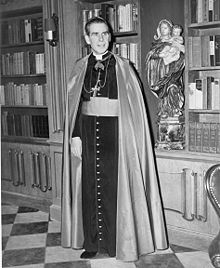Ferraiolo


The ferraiolo (also ferraiuolo, ferraiolone) is a type of cape traditionally worn by clergy in the Roman Catholic Church on formal, non-liturgical occasions. It can be worn over the shoulders, or behind them, extends in length to the ankles, is tied in a bow by narrow strips of cloth at the front, and does not have any 'trim' or piping on it.
The colour of the ferraiolo is determined by the rank of the cleric, being black for secular priests, violet for supernumerary protonotaries apostolic and bishops and scarlet watered silk for cardinals.[1] A ferraiolo of watered silk also denotes the wearer is an apostolic nuncio or is attached to the Papal household. The Pope does not wear a ferraiolo.
Special privileges[]
Even in modern times of the 21st century, the Order of Canons Regular of Premontre (Premonstratensians, Norbertines or white canons), the Camaldolese, the members of the Orders of Our Lady of Mercy and of the Holy Trinity, and the Olivetans, as well as a few other orders who wear a prelatical costume have the privilege of wearing the ferraiolo entirely of white cloth. The Premonstratensians also have the privilege of wearing this garment with a white four-cornered biretta of the same material. Some white canons even choose to wear white shoes when dressed in this formal attire. The additional items traditionally worn by the clergy, i.e. cincture or sash is also entirely white. The Canon Regular is allowed to wear a surplice for any liturgical circumstance and the rochet for non-liturgical events, but not worn with the ferraiolo. The Premonstratensian canon, as a simple priest, deacon or seminarian is permitted to wear the (filed or textured charmeuse) ferraiolo, band cincture/sash with braided fringe and biretta (without pom) entirely made of white cloth, unlike the secular priests who must wear a black wool ferraiolo. The Premonstratensian Abbots regiminis, as well as Abbots nullius, are permitted to wear the ferraiolo of watered silk and add to their monastic habit the pectoral cross and the ring. This same regular prelate or abbot, who also as a Canon Regular, may wear a biretta (with pom). In addition to wearing the other privileged items, the mantelletta, made of the same cloth of his monastic habit, may be worn by an abbot who is not in his own monastery of record, but worn without the ferraiolo.

Dress codes[]
Three documents effected the simplification of Latin Rite clerical dress after the Second Vatican Council, which together comprise the present ecclesiastical law on clerical dress. The first is the Instruction of the Secretariat of State of 31 March 1969, Ut sive sollicite (USS) on the dress, titles, and coat of arms of cardinals, bishops, and lesser prelates. The second is the Circular Letter of the Sacred Congregation for the Clergy of 30 October 1970, Per Instructionem on the reform of choir dress, which applied the prescriptions of USS to canons, beneficiaries, pastors, and, by explicit extension, all other ecclesiastical ranks. Neither of these documents provided synthetic schemata of the forms of dress of all secular and religious clergy of the Latin Rite, but rather amended the preexisting paradigms. A more systematic list of the forms of dress, that relied on these two previous documents and partially augmented them, was provided by the first appendix of Caeremoniale Episcoporum (CE) on the dress of prelates. However, even CE did not provide every detail, as it presupposed the sartorial customs of the Latin Rite and did not treat the dress of ecclesiastics under the rank of prelate and canon. For the pre-conciliar paradigms and for the perduring sartorial customs of the Latin Rite concerning details of which these documents were silent, reference is to older documents, the best of which is Nainfa's Costume of Prelates of the Catholic Church.[1] The customs and documents of the Church can only express the dignity of wearing such formal dress in the appropriate venues, such as academic commencements, formal balls, dinners, and other local or state gatherings that mandate wearing formal attire.
As with many other items of clerical clothing and vestments, the ferraiolo originated as an item of clothing for ancient Roman citizens, originally extending to the knee.
References[]
| Wikimedia Commons has media related to Ferraiolo. |
- John Abel Nainfa, SS: Costume of Prelates of the Catholic Church: According to Roman Etiquette, Revised Edition (Baltimore, Maryland, USA: John Murphy Company, 1926).
Notes[]
- ^ Ceremonial of Bishops, Cæremoniale Episcoporum. Congregation for Divine Worship, 14 Sep 1984. 1205.
- Catholic clerical clothing